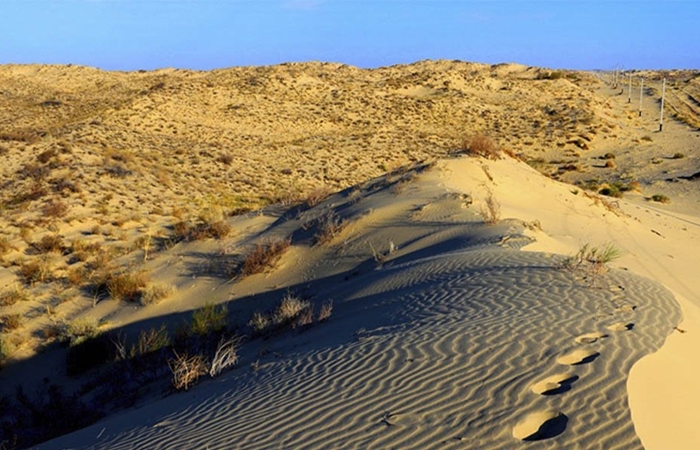As part of strengthening scientific collaboration, a Turkmen-Chinese team of scientists from the National Institute of Deserts, Flora, and Fauna (NIDFF) of the Ministry of Environmental Protection of Turkmenistan and the Xinjiang Institute of Ecology and Geography of the Chinese Academy of Sciences visited several research sites in the Karakum Desert, reports the newspaper “Neutral Turkmenistan.”
Located 60 km north of Ashgabat in the Central Karakum, the “Garryköl” station serves as a long-standing base for studying precipitation collection on takyrs in desert conditions.
Senior researcher of the Laboratory of Forests and Pastures, Guljamal Kurbanmamedova, conducted a tour for Chinese colleagues, detailing the history of pistachio plantings on dunes, care for trees up to 40 years old and young saplings, and showcasing a saxaul nursery. The Chinese scientists, familiar with the harsh conditions of the Gobi Desert, were particularly impressed by the fruit-bearing pistachio trees.
Special attention was given to irrigation and water storage practices. A sloped takyr spanning 150 hectares and a large-capacity ditch collect spring floods. Residual moisture at the bottom of the reservoir supports the growth of camel thorn, and other plants. Water collected in barrels during rainfall is used for irrigation in summer, while a well provides an additional source during the dry season. This well-established system sustains and expands the plant collection.
The Chinese delegation also inspected dune areas where sand stabilization and phytomelioration measures were implemented, including around the “Altyn Asyr” bazar near Ashgabat.
Head of the Laboratory of Desertification Monitoring and Sand Stabilization, Khalmukhammet Ataev, noted that after analyzing the “wind rose,” sands were stabilized with reed mats over 30 hectares. Inside the market, a cultural zone was created with bosquets, coniferous, and deciduous plants (20,000 saplings of Eldar pine, eastern thuja, and mulberry) under drip irrigation. Externally, plantings of black and white saxaul, kandym, and cherkez (80,000 saplings) prevent sand drift. After 14 years, the market has become a comfortable area free of wind and sand.
The delegation examined a sardoba [rainwater and meltwater catchments], studied the plant species composition, and observed the seasonal grazing of sheep and Arvana breed dromedary camels. The visit continued at the “Çalyş” Scientific-Experimental Center of the “Bereketli Garagum” State Nature Reserve.
The cultural program included sightseeing in Ashgabat and a visit to the city of Arkadag, where the scientists explored the administrative building of the agro-industrial complex.
The delegation head, Deputy Director of the Xinjiang Institute of Ecology and Geography, Professor Abuduwaili Jilili, emphasized the value of the experience exchange: “This is our second visit to Turkmenistan, which allowed us to gain a deeper understanding of Karakum development and the protection of fragile natural systems. Our deserts in China are slightly smaller than the Karakum, yet we address similar challenges, conducting afforestation, reclamation, and land preparation for construction. Our interaction was mutually beneficial, and we hope this scientific partnership will yield results valuable to both sides.” ///nCa, 9 June 2025
